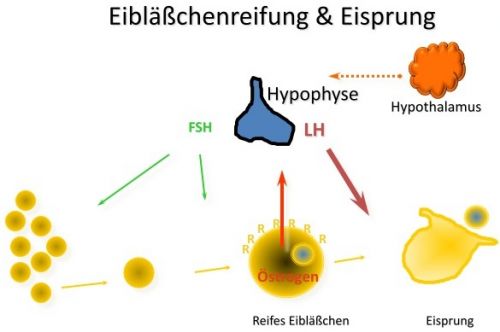Hormonal disorders
Regular interaction of several hormones is important so that normal ovulation may occur and for preparation of the uterine endometrium for future nidation of the embryo.
|
A superordinated part of the brain, the hypothalamus, secretes the GnRH (gonadotropin-releasing hormone). This hormone causes the pituitary gland (hypophysis) to release the follicle stimulating hormone (FSH) and the luteinizing hormone (LH) in the circulation. It is in this way that both hormones reach the ovaries. Once there, they trigger the growth of an ovarian follicle during the first 14 days of a normal 28-day monthly cycle. When the follicle is large and mature enough, it is released into the tubes, marking the ovulation. The ovarian follicle produces estradiol (E2), which ensures that the uterine endometrium grows again after the menstruation. |
|
|
After the ovulation, the empty ovarian follicle becomes the so called yellow body (corpus luteum). It produces high amounts of progesterone (P), which prepares the uterine endometrium for the possible arrival of an embryo. If pregnancy occurs, the yellow body is retained and menstruation ceases. If not, the yellow body is degraded, progesterone levels fall and menstruation continues. In this fascinating sequence, many things can go wrong. At the beginning of treatment, the levels of these hormones are detected by blood sample testing and ultrasound examination, in order to determine to condition of the ovaries and the |
|



